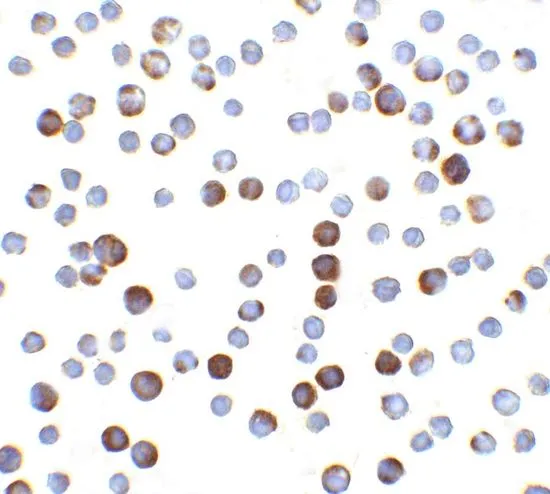Caspase 9 (cleaved Asp330) antibody
GTX132331
ApplicationsWestern Blot
Product group Antibodies
TargetCASP9
Overview
- SupplierGeneTex
- Product NameCaspase 9 (cleaved Asp330) antibody
- Delivery Days Customer9
- Application Supplier NoteWB: 1:500-1:3000. *Optimal dilutions/concentrations should be determined by the researcher.Not tested in other applications.
- ApplicationsWestern Blot
- CertificationResearch Use Only
- ClonalityPolyclonal
- Concentration2.73 mg/ml
- ConjugateUnconjugated
- Gene ID842
- Target nameCASP9
- Target descriptioncaspase 9
- Target synonymsAPAF-3, APAF3, ICE-LAP6, MCH6, PPP1R56, caspase-9, ICE-like apoptotic protease 6, apoptotic protease MCH-6, apoptotic protease activating factor 3, caspase 9, apoptosis-related cysteine peptidase, protein phosphatase 1, regulatory subunit 56
- HostRabbit
- IsotypeIgG
- Protein IDP55211
- Protein NameCaspase-9
- Scientific DescriptionThis gene encodes a member of the cysteine-aspartic acid protease (caspase) family. Sequential activation of caspases plays a central role in the execution-phase of cell apoptosis. Caspases exist as inactive proenzymes which undergo proteolytic processing at conserved aspartic residues to produce two subunits, large and small, that dimerize to form the active enzyme. This protein can undergo autoproteolytic processing and activation by the apoptosome, a protein complex of cytochrome c and the apoptotic peptidase activating factor 1; this step is thought to be one of the earliest in the caspase activation cascade. This protein is thought to play a central role in apoptosis and to be a tumor suppressor. Alternative splicing results in multiple transcript variants. [provided by RefSeq, May 2013]
- Storage Instruction-20°C or -80°C,2°C to 8°C
- UNSPSC12352203
References
- Size-Based Effects of Anthropogenic Ultrafine Particles on Lysosomal TRPML1 Channel and Autophagy in Motoneuron-like Cells.Read more
- Neuroprotective effect of Na+ /H+ exchangers isoform-1 inactivation against 6-hydroxydopamine-induced mitochondrial dysfunction and neuronal apoptosis in Parkinsons disease models. Xing R et al., 2021 Nov, Drug Dev ResRead more
- Co-delivery of homoharringtonine and doxorubicin boosts therapeutic efficacy of refractory acute myeloid leukemia. Yan D et al., 2020 Nov 10, J Control ReleaseRead more
- Orabase-Formulated Benzalkonium Chloride Effectively Suppressed Oral Potentially Malignant Disorder In Vitro and In Vivo. Wang YY et al., 2020 Mar 31, ACS OmegaRead more
- MicroRNA-378-3p/5p represses proliferation and induces apoptosis of oral squamous carcinoma cells via targeting KLK4. Cui Z et al., 2020 Apr, Clin Exp Pharmacol PhysiolRead more
- The activation of Mucolipin TRP channel 1 (TRPML1) protects motor neurons from L-BMAA neurotoxicity by promoting autophagic clearance. Tedeschi V et al., 2019 Jul 24, Sci RepRead more
- Astrakurkurone, a sesquiterpenoid from wild edible mushroom, targets liver cancer cells by modulating Bcl-2 family proteins. Dasgupta A et al., 2019 Jul, IUBMB LifeRead more
- Melatonin Sensitizes Hepatocellular Carcinoma Cells to Chemotherapy Through Long Non-Coding RNA RAD51-AS1-Mediated Suppression of DNA Repair. Chen CC et al., 2018 Sep 10, Cancers (Basel)Read more
- Corylin increases the sensitivity of hepatocellular carcinoma cells to chemotherapy through long noncoding RNA RAD51-AS1-mediated inhibition of DNA repair. Chen CC et al., 2018 May 1, Cell Death DisRead more

![WB analysis of active 293 (lane 2) and inactive 293 cell lysate(lane 1) using GTX30245 Caspase 9 antibody [LAP6 96-2-22].](https://www.genetex.com/upload/website/prouct_img/normal/GTX30245/GTX30245_1377_WB_w_23060722_265.webp)




![IHC-P analysis of human stomach cancer tissue using GTX34168 Caspase 9 antibody [3-20]. Negative control (the lower left coner) was secondary antibody only. Antigen retrieval : Sodium citrate pH6.0 was used for antibody retrieval (>98oC, 20min) Dilution : 1:200](https://www.genetex.com/upload/website/prouct_img/normal/GTX34168/GTX34168_20200622_IHC-P_031_w_23060801_362.webp)
